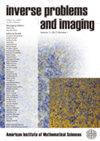基于直接算法的小尺寸位错辨识与稳定性研究
IF 1.5
4区 数学
Q2 MATHEMATICS, APPLIED
引用次数: 0
摘要
本文研究了在假设位错线周围区域较小的情况下,从边界测量中识别三维材料中曲线型位错线的问题。这个反问题的目标是重建这些位错的数量、初始位置和某些特征,并利用某些测试函数建立中心的Hölder稳定性。本文可以看作是对[9]的推广,与上一篇文章重构逐点的位错不同,我们的目标是通过直接代数算法恢复直线位错的参数。本文章由计算机程序翻译,如有差异,请以英文原文为准。
Identification and stability of small-sized dislocations using a direct algorithm
This paper considers the problem of identifying dislocation lines of curvilinear form in three-dimensional materials from boundary measurements, when the areas surrounded by the dislocation lines are assumed to be small-sized. The objective of this inverse problem is to reconstruct the number, the initial position and certain characteristics of these dislocations and establish, using certain test functions, a Hölder stability of the centers. This paper can be considered as a generalization of [9], where instead of reconstructing point-wise dislocations, as done in the latter paper, our aim is to recover the parameters of line dislocations by employing a direct algebraic algorithm.
求助全文
通过发布文献求助,成功后即可免费获取论文全文。
去求助
来源期刊

Inverse Problems and Imaging
数学-物理:数学物理
CiteScore
2.50
自引率
0.00%
发文量
55
审稿时长
>12 weeks
期刊介绍:
Inverse Problems and Imaging publishes research articles of the highest quality that employ innovative mathematical and modeling techniques to study inverse and imaging problems arising in engineering and other sciences. Every published paper has a strong mathematical orientation employing methods from such areas as control theory, discrete mathematics, differential geometry, harmonic analysis, functional analysis, integral geometry, mathematical physics, numerical analysis, optimization, partial differential equations, and stochastic and statistical methods. The field of applications includes medical and other imaging, nondestructive testing, geophysical prospection and remote sensing as well as image analysis and image processing.
This journal is committed to recording important new results in its field and will maintain the highest standards of innovation and quality. To be published in this journal, a paper must be correct, novel, nontrivial and of interest to a substantial number of researchers and readers.
 求助内容:
求助内容: 应助结果提醒方式:
应助结果提醒方式:


